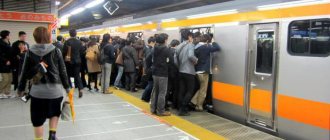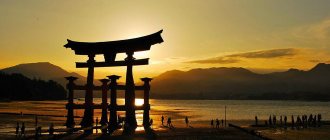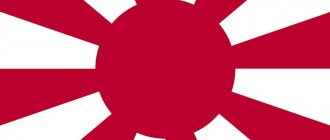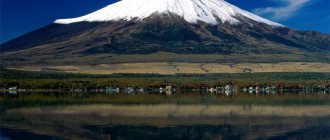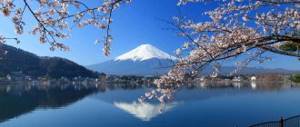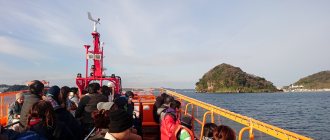The opinion that the economy of the Land of the Rising Sun is in decline today is erroneous. One glance at the map of the Japanese transport system is enough to convince you of this. Transport in Japan is required to cope with serving more than 100 million people on a very small piece of land and is therefore very highly developed. The country is investing heavily in infrastructure. Today there are about 1.2 million km of roads and more than 27 thousand km of railways, the incredible intertwining of which not every Japanese can understand.
General information
A single network of high-speed toll roads and about 250 Shinkansen bullet trains connect major cities, and dozens of railway companies compete in regional and local transportation markets.
Japan's largest domestic airport, Haneda, is the busiest in Asia. The country's main air gates - Narita, Kansai and Chubu international airports - regularly appear in rankings of the largest in terms of traffic.
Through Japan's largest port, Nagoya, with a cargo turnover of over 210 million tons per year, Japanese goods, including cars, are distributed en masse around the world.
Public transport in Japan is more developed than anywhere else and includes complex systems of subways, trains, buses, monorails, trams and ferries operated by different owners. It is the latter circumstance that greatly complicates the lives of passengers. You have to buy several tickets, since there are no single tickets for all operators.
In Tokyo, you can use non-personalized reloadable PASMO and Suica cards. You can use them to pay for travel on the subway, trains and some buses. The system automatically calculates the tariff and debits funds from the card, which must be replenished regularly.
From September 1, 2021, a Welcome Suica travel card with a validity of 28 days, created specifically for tourists, is available throughout the country. Also for 1,590 yen (child costs 800 yen) you can purchase a one-day Tokyo 1-Day Ticket (Tokyo Free Kippu or Tokyo Combination Ticket), which provides unlimited travel on the Tokyo Metro, Toei, Toden tram, most Toei buses, and the Nippori Line and all Japan Railways (JR) lines within the urban area.
HiSoUR Cultural history
Transport in Japan is modern and highly developed. Japan's transport sector stands out for its energy efficiency: it uses less energy per person compared to other countries, thanks to a high share of rail transport and low overall travel distances. Transport in Japan is also very expensive by international comparison, reflecting high duties and taxes, especially on road transport.
Japan's spending on roads was large. The main mode of transport is 1.2 million kilometers of paved roads. Japan drives on the left. A single network of expressways, divided and limited toll roads connects major cities, which are operated by toll-collecting businesses.
Dozens of Japanese railway companies compete in regional and local passenger markets; for example, the seven JR Group companies, Kintetsu Railway, Seibu Railway and Keio Corporation. Often these businesses' strategies include real estate or department stores near stations. About 250 high-speed Shinkansen trains connect major cities. All trains are known for punctuality.
There are 176 airports, and the largest domestic airport, Haneda Airport, is Asia's busiest airport. The major international gateways are Narita International Airport (Tokyo area), Kansai International Airport (Osaka/Kobe/Kyoto area), and Chubu Centrair International Airport (Nagoya area). Major ports include the Port of Nagoya.
overview Before the introduction of steam engines and internal combustion engines, Japanese rulers were not very favorable towards intensifying the movement. The reason for this is tradition, order and military reasons. In "Nihon Shoki" there are also many gods ("Arasami") that interfere with the movement of people ("Arasami") and the existence of local residents, even immediately after the revival of Taika, travelers do not consider the customs of the area. are descriptions that are considered problematic that local people punish themselves for committing them. To form the state as a nation, Japan also maintains major roads connecting the capital and prefectures of the countries. However, transportation between rural areas was supposed to help farmers escape, so it was unlikely to be supported except by large government agencies, and it was believed that only in the regional river should be transferred to Funabashi with an annual contribution to the capital (Emergency Calendar of the "Japanese Era" May 20 in Kojo Even in the Edo era, for military and political reasons, bridges could not be built on large rivers, slavery was prohibited (anti-nuclear policy) and the prohibition of building a large ocean-going vessel (part of samurai law) and reasons for protecting Edo Adopted a policy prohibiting logistics using vehicles such as cattle cars, etc. on highways. For this reason, Japanese roads are rarely paved, and vehicles using wheels were used only for carrying luggage, such as the large octave, there were only cows. Restrictions were also added on the use of horses.Kawatani and small commercial merchant ships are used to transport goods, and waterways are developed in major cities.
After the Meiji Restoration, Japan will grow to its modern state. The priority was to create a railway network. For roads, full-scale maintenance began after World War II. During the period of high economic growth, a highway, a full-fledged highway, appeared for the first time in Japan (Meishin Expressway). After this, Shinkansen and City Expressway maintenance began with the Tokyo Olympics in 1964 and the Osaka Expo in 1970, and now a network of expressways totaling 14,000 km has been developed, as well as Shinkansen maintenance continued. However, with the development of motorization, the decline of the urban core area has been strained in various aspects.
Traffic history
Rite Period In ancient times, along with the improvement of the system of rules, a station system was established, the road was improved between the capital (Kiuchi) and the region, station stations were established. It is called the ancient government road, but the ancient government road was developed along the Seo-seku area, which is a regional area.
Segwayo, Gifu: Kiuchi, Saikai road, Nankai road, Sanyo road, San'in road, Tokaido, Higashiyama road, Hokuriku road Before the Sengoku period Edo period With Edo as the new center, highway improvements were promoted throughout Japan. With economic development, water movement became popular, and marine cargo passages and canal services were developed.
highway Post Office Development Five roads (starting point: Nihonbashi): Tokaido, Nakasendo, Koshu Kaido, Oshu Kaido, Nikko Kaido Tarbo-barrel, Rigaki Sailboard Magome, horse (Majiko), Kitayama ship, etc.
From Meiji to World War II Upon entering the Meiji era, it was necessary to develop the transportation network in order to become a modern state. To make maintenance easier, it was built with railroad priority over road. Although there were many problems and obstacles in the construction of the railway, after temporary sales began between Shinagawa and Yokohama, sales began between Shimbashi and Yokohama. To this end, the construction of the railway was promoted by public and private. Tram trains and subways were retained in the city, and the installation and installation of gas lights was advanced for horse racing. However, local road improvements continued slowly and there were many areas that were not suitable for motor vehicles to travel on arterial roads.
Rickshaw, horse-drawn railway, human railway, etc.: In the early Meiji era, land is scarce, and steep mountainous land is a lot of land in the country → tunnel
After World War II Highway development did not advance significantly until the end of World War II and the level of road surface was very low even on the national highway. To revive the economy, the Nagoya·Kobe Expressway (current Meishin Expressway) linking Nagoya and Kobe was planned, but since the traffic engineering engineers who plan the expressway were not in Japan, the United Nations. The plan was drawn up with a request. This is the Watkins Report, released in 1956. Among them: "Japan's road is incredibly bad, just like industrialized countries, there is no other country other than ignorant of the road in this way." This report will also intensify, and Japan's highway development will advance rapidly.
For the railroad, the transition from the steam locomotive to the diesel (diesel) car and electrification were accelerated.
In Japan, which was limited in aircraft development due to the defeat of the aircraft, this did not harm the aircraft industry, but many of the technicians active before the war lent their support to the growth of the Japanese automobile industry for a change.
Along with the 1964 Tokyo Olympics came the construction of the Tomei Highway and the opening of the Tokaido Shinkansen. The Tokyo Metropolitan Expressway also opened partially in 1962, which was also the first expressway in Japan. From the second half of the 60s, the popularity of my cars was in full swing, and the number of cars increased sharply (motorization). On the other hand, road accidents have also increased sharply due to delays in improving road and vehicle usage and this has been termed as a war on the roads. The appearance of a reckless family also became a problem. As a countermeasure against traffic accidents, the separation of road vehicles has been achieved by installing pedestrian crossings such as crosswalks. In 1971, the number of cars owned reached 10 million units (Showa 46).
Although the conventional railway is stagnating with the tide of motorization progress, the Shinkansen high-speed passenger railway will rise to the Japanese aorta. The success of Japan's Shinkansen, which bridges the gap between road and air passenger transport, has increased momentum for the review of railways, which have been unable to stagnate and has encouraged European and Asian countries to also introduce high-speed passenger rail.
In Japan, which relies heavily on foreign resources, shipbuilding technologies have been developed since the start of the war, and large tankers and other structures were actively built after the war, along with the steel industry, which played a role in Japan's economy and logistics. Airport maintenance was promoted and air transport gradually expanded. After the 1980s, as the value of the yen increased further, business and overseas travel became active.
Rail In Japan, railways are the main means of passenger transport, especially for mass and rapid transport between major cities and commuter transport in urban areas. The seven companies of the Japanese Railways Group, state-owned before 1987, cover most areas of Japan. There are also railway services operated by private railway companies, regional governments and companies financed by both regional governments and private companies.
The total of 27,182 km of railways includes several tracks, the most common being 1,067 mm (3 ft 6 in) narrow gauge, with 22,301 km of track, of which 15,222 km are electrified.
Fukuoka, Kobe, Kyoto, Nagoya, Osaka, Sapporo, Sendai, Tokyo and Yokohama have subway systems.
Most Japanese people traveled on foot until the later part of the 19th century. The first railway was built between Shimbashi Station in Tokyo and Yokohama's former Yokohama Station (now Sakuragichi Station) in 1872. After this, several more railways soon appeared. Japan, as we know it today, is home to one of the world's most extensive transportation networks. Mass transportation is well developed in Japan, but the road system is lagging and inadequate for the number of cars owned by Japan. This is often attributed to the fact that road construction in Japan is difficult due to its unique high population density and limited amount of available space for road construction.
Shinkansen (Bullet Trains) Shinkansen, or "bullet trains" as they are often called, are high-speed rail trains that travel throughout Japan. 2,387 km (1,485 mi) of the 8 Shinkansen lines operate on completely separate lines from their train counterparts, with a few exceptions. The Shinkansen takes up the majority of long-distance travel in Japan, with the entire system carrying more than 10 billion passengers in its lifetime. There are 1,114 services daily, with the fastest train being the JR East E5 and E6, which operate at a top speed of 320 km/h (200 mph). Shinkansen trains are known to be very safe, with no accidental deaths or injuries from passengers in their 50-year history. Shinkansen trains are known to be very punctual, following the example of all Japanese vehicles; in 2003, the average train delay on the Tokaido Shinkansen was only 6 seconds. Japan is trying to sell its Shinkansen technology abroad and has struck deals to help build systems in India, Thailand and the United States.
The first Shinkansen line opened between Tokyo and Osaka in 1964, and trains can now complete the journey in 2 hours and 25 minutes. Additional Shinkansen lines connect Tokyo to Aomori, Niigata, Kanazawa and Hakodate, and Osaka to Fukuoka and Kagoshima, with new structures under construction to Tsuruga, Sapporo and Nagasaki.
Japan is developing technological trains in Malwela and in April 2015 broke the world record speed record, with the train setting off at 603 km/h (375 mph). Chūō Shinkansen, a commercial Maglev service, is currently under construction from Tokyo to Nagoya and Osaka, and when completed in 2045, it will cover the distance in 67 minutes, half the time of the current Shinkansen.
Road According to the 2015 Statistical Yearbook of Japan, Japan had approximately 1,215,000 km of roads in April 2012, consisting of 1,022,000 km of urban, urban and rural roads, 129,000 km of prefectural roads, 55,000 km of general national highways and 8,050 km of national expressways. Foreign Press Center/Japan cites the total length of expressways as 7,641 km (in fiscal year 2008). A single network of expressway, divided, limited toll roads connects major cities in Honshu, Shikoku and Kyushu. Hokkaido has a separate network, and the island of Okinawa has this type of highway. In 2005, the toll collection companies, formerly the state-owned Japan Highway Corporation, were converted into private, government-owned companies, and there are plans to sell some of them. The purpose of this policy is to stimulate competition and reduce tariffs.
Road passenger and freight transportation expanded significantly in the 1980s as private ownership of motor vehicles increased significantly, along with the quality and extent of the country's roads. Bus companies, including JR Bus, operate intercity bus routes on the country's expanding expressway network. In addition to relatively low fares and luxurious seats, buses are well used because they continue to provide service at night when air and rail services are limited.
The freight sector grew rapidly in the 1980s, recording 274.2 billion tonne-kilometres in 1990. Freight transported by road vehicles, mostly trucks, totaled more than 6 billion tons in 1990, accounting for 90 percent of domestic freight tonnage and about 50 percent of tonne-kilometers.
Recent major infrastructure projects include the Great Seto Bridge and the Tokyo Bay Aqua Line (opened 1997).
Although the number of traffic fatalities has decreased, partly due to stricter enforcement of drunk driving laws, there were still 7,358 deaths on Japanese roads in 2004.
airline In 2013, Japan had the fourth largest passenger air travel market in the world with 105,913,000 passengers. In 2013, there were 98 airports in Japan. The main international gateways are Narita International Airport (Tokyo area), Kansai International Airport (Osaka/Kobe/Kyoto area) and Zhubu Centrair International Airport (Nagoya area). The main domestic hub is Tokyo International Airport (Haneda Airport), Asia's busiest airport and the world's 4th busiest airport; other major transportation hubs include Osaka International Airport, New Chitosesa Airport outside of Sapporo, and Fukuoka Airport. There are an estimated 14 heliports (1999).
The two main airlines are Japan Airlines and All Nippon Airways. Other passenger services include Skymark Airlines, Skynet Asia Airways, Air Do, Star Flyer and Fuji Dream Airlines. United Airlines and Delta Air Lines, formerly Northwest Airlines, are major international operators from Narita Airport.
Domestic air travel in Japan has historically been heavily regulated. Since 1972, the three major domestic airlines (JAL, ANA and JAS) have had designated routes, using JAL and ANA mainline routes, and ANA and JAS using local feeder routes. JAL and JAS have since been merged to help compete with ANA. JAL also held a flag carrier monopoly on international routes until 1986. Fleet rates were set by the government until 2000, although carriers had the right to adjust standard fares starting in 1995 (when discounts of up to 50% were allowed). Today, tariffs can be set by carriers, but the government retains the ability to veto tariffs that are too high.
Waterways Japan has 1,770 km of waterways; seagoing vessels use all coastal inland seas.
As of April 2014, there are 994 ports in Japan. These ports have overlapping classifications, some of which are multi-purpose, such as cargo, passenger, marine and fishing. The five designated "super" container ports are Yokkaichi, Yokohama, Nagoya, Kobe and Osaka. 23 are designated major/international, 125 are designated important, while there are also purely fishermen's ports.
Twenty-three major seaports designated as important important ports by the Ministry of Land, Infrastructure, Transport and Tourism: Chiba, Fushiki/Toyama, Himeji, Hiroshima, Kawasaki, Kitakyushu, Kobe, Kudamatsu, Muroran, Nagoya, Niigata, Osaka, Sakai/Senpoku, Sendai/Shiogama, Shimizu, Shimonoseki, Tokyo, Tomakomai, Wakayama, Yokkaichi and Yokohama.
Japan has 662 ships of 1,000 gross register tons (GRT) or more, amounting to 13,039,488 gross register tons (GRT) or 18,024,969 deadweight tons (DWT). There are 146 mass vessels, 49 cargo ships, 13 chemical tankers, 16 mixed feed, 4 combined ore and oil, 25 containers, 45 liquefied gases, 9 passenger, 2 passenger and cargo combination ships, 214 oil tankers, 22 refrigerated cargo. 48 roller ships, 9 passenger ships and 60 vehicles (1999).
Ferries connect Hokkaido to Honshu, and Okinawa Island to Kyushu and Honshu. They also connect other smaller islands and the main islands. Planned international passenger routes operate to China, Russia, South Korea and Taiwan. Coastal and inter-channel ferries on the main islands have been declining on routes and frequencies following the development of bridges and expressways, but some are still operating (as of 2007).
Pipelines Japan has 84 km of pipelines for crude oil, 322 km for petroleum products and 1,800 km for natural gas.
Share link:
- Click to share on Twitter (Opens in new window)
- Click here to share content on Facebook. (Opens in a new window)
- Click to share on Pinterest (Opens in new window)
- Click to share posts on Tumblr (Opens in new window)
- Click to share on LinkedIn (Opens in new window)
- Click to share on WhatsApp (Opens in new window)
- Click to share on Skype (Opens in new window)
- Click to share on Telegram (Opens in new window)
- Click to share on Reddit (Opens in new window)
- Click to share posts on Pocket (Opens in new window)
Related
Share: Twitter Facebook Google+
Japanese subway
The metro in Japan is represented in nine major cities: Fukuoka, Kobe, Kyoto, Nagoya, Osaka, Sapporo, Sendai, Tokyo, Yokohama, Hiroshima. It is considered the most convenient way of transportation.
The fare depends on the travel distance, tariffs and the number of operators servicing individual lines. For example, on Tokyo Metro lines it is 160 yen, and on the Toei municipal subway it is 170 yen.
The cost of a trip to a specific station is indicated on the metro line map. There are no through routes; at the final stops you have to get off and buy another ticket or pay extra at the yellow Fare Adjustment machines.
Here you need to insert the ticket into the slot - and the amount that needs to be paid will be displayed on the board. After paying extra, you can go through the turnstile.
Signs on a blue background direct to the platforms, and on a yellow background - to the exits. The stations are equipped with controllers at the entrance and exit to the cars. By the way, the latter are equipped with the latest technology.
Boarding on the metro is carried out one by one, along special markings on the floor of the platform. There is free Wi-Fi here, but cell phone conversations are prohibited. Stations are announced in Japanese and English. Train intervals are 5 minutes.
On some lines, women-only carriages run during peak hours. As a rule, they are located at the tail of the train and are marked with special stickers.
Features of the urban public transport system. Universal travel tickets
When I started to understand public transport, the main problem was to understand which of the many companies served a particular bus line or subway line. The presence of several carriers is accompanied by the presence of each of them their own tickets and their distribution networks. Because of this, for example, when transferring from a subway line operated by Tokyo Metro to a line operated by Toei, you will need to buy an additional ticket.
Tokyoites who frequently use the subway certainly do not consider this a major problem. They have long been accustomed to this situation and have gotten used to it. But for a tourist this can be a serious obstacle and seriously ruin the day. Therefore, I would say that the best recommendation is the following - do not try to understand this system, but focus on choosing the most suitable special travel ticket for you, valid for all types of urban transport.
These include Tokyo:
- Universal travel pass PASMO - buses, metro, city trains.
- The Suica Pass is a vehicle that is not part of the Japan Railways system.
- Orange Card – all types of Japan Railways transport.
- One-day Tokyo Rail Pass – all types of transport Japan Railways.
Travel cards are refillable; they are purchased with a prepaid number of trips from vending machines or ticket offices at train stations, metro and bus stations. Using a travel card not only makes travel in cities more convenient, but also allows you to get a small discount on tickets (usually within 10% of the standard one).
In Osaka, the most convenient one is the Osaka Amazing Pass. In addition, there are regional travel tickets, valid, for example, in the Kansai region or Hokkaido.
In general, from my own experience I can say that the Tokyo PASMO and Suica passes will cover almost all the needs for intracity travel.
Japanese bus
City buses are not popular in Japan, although the network is well developed and allows you to quickly get to the main attractions.
At the stops there is an information board with comprehensive information about the routes in English. Boarding is through the front door, and exit is through the middle or rear door.
The fare is paid at a special machine next to the driver. If you don’t have a pass, you can buy a ticket from him by naming your stop. The amount can be found out by the display located above the windshield.
The machine has slots for coins (with openings for 25 and 50 yen does not accept) and bills, a compartment for change and a reader for travel cards. A day pass purchased in advance can simply be presented to the driver. To exit, you need to press the button on the handrail.
The buses have air conditioning and free Wi-Fi.
The schedule and location of stops can be found on the official website of the bus company. The cost of travel is relatively low. For example, in the central zone of Tokyo it is 120–150 yen ($1.2–1.5).
In other cities, communication is most often organized according to the principle of transport zones. Schemes and approximate cost of the trip can be found at bus stops and on buses.
Major bus carriers offer multi-day passes. For example, the 10,000 yen Willer Express Pass allows you to travel on the company's buses for three days without any travel restrictions.
This is a very inexpensive, but not so fast way to travel. Flights are day and night.
Trams and trolleybuses: a Japanese attraction
Trolleybuses have never been common in this country. Today, from the windows of the only trolleybus in Japan, only the walls of the tunnel are visible, since it has become underground.
As of 2021, the two existing lines are completely exotic. Trolleybuses from Tateyama Kurobe Kankō Company and Kansai Electric Power Company are used to transport tourists to Mount Tate in the Japanese Alps. These are ultra-modern, well-equipped and very comfortable cars. A ticket for passengers over 12 years old costs 8,290 yen, for children ─ 4,150. It can be purchased at the ticket office at the beginning of the route.
There are very few trams in Japanese cities. Tram systems exist in Sapporo, Hakodate, Kamakura, Toyohashi, Toyama, Kyoto, Osaka, Okayama, Hiroshima, Matsuyama, Kochi, Nagasaki, Kumamoto and Kagoshima.
Tokyo's once-excellent tram system has given way to rapid transit. There are only two routes left in the center and one in the suburbs ─ Kamakura. By the way, the last one, “Enoden”, with its antique trailers, looks more like a tourist one.
There are no conductors on the tram. The fare is 170 yen for an adult and 90 yen for a child. Travel is paid at the entrance. The machine does not issue tickets or change.
Classics of the genre
Trams in Japan are considered exotic. You can count them on your fingers. One branch operates in Tokyo. Others serve the suburbs of the country's megacities. They are designed for curious tourists. Their speed is low, but the trams do not get stuck in traffic jams. Trolleybuses have also been preserved in Japan.
Unlike Russian models, Japanese ones run underground. They head to the top of Tate Mountain Peak. They are used to serve tourist groups. These are modern and comfortable cars that are a worthy example of environmentally friendly transport. Japanese trolleybuses move in a tunnel reminiscent of a subway.
Railway
Rail transport is the main means of transportation. The seven companies of the Japan Railways (JR) group cover most of the needs. Japanese trains always run exactly on schedule, and the high-speed Shinkansen 500 and N700 series reach a maximum speed of 300 km/h.
The company provides services: super-express, courier, express with sleepers and reserved seats. The fare depends on the distance and class of carriage. If you use the window (midori-no-madoguchi), you can purchase tickets for carriages of various classes over long distances.
In cities, tickets for local lines can be purchased from special vending machines located at stations.
The Japan Rail Pass, intended for travelers, can only be purchased outside of Japan. The ticket entitles you to unlimited travel on JR trains, buses and ferries, with the exception of the Nozomi Super Express.
Trains
Japan is surrounded by a very dense network of railways and almost all interesting places in the country can be reached by train. In addition, along the eastern and southern coasts of the main Japanese island of Honshu, as well as along the western coast of the island of Kyushu, the famous Shinkansen high-speed trains owned by Japan Railways run, rightfully one of the symbols of Japan. Shinkansen reach speeds of up to 300 km/h, and recently an even faster E5 model was launched between Tokyo and Shin-Aomori.
The fastest of the Shinkansen are called limited express trains, which stop only at the largest stations. They are followed in decreasing speed by regular express trains (express), fast trains (rapid) and commuter trains (futsu).
Author's guide to Japan - click here!
Shinkansen usually have several first class cars (green class) - they differ from ordinary cars in the ordinary category by wider and more comfortable seats and increased space between the rows of seats. The newest trains have Gran Class carriages, where the comfort of seats corresponds to business class on JAL aircraft.
Interior of an ordinary category carriage
Interior of a green class carriage
In addition to dividing into classes, cars in shinkansen are also of two types: with reserved seats (reserved seats) and with non-reserved seats (non-reserved seats). Reservations in the second type of carriage are more expensive, and on ordinary days it is not worth it - there are almost always empty seats in the carriages. It makes sense to book a place in advance only during national Japanese holidays and vacations, when the Japanese begin to migrate en masse across the country. However, there are shinkansen where it is necessary to reserve seats in advance - for example, the Komachi train to Tohoku. JR Pass holders can reserve seats for free.
JR Pass
If you plan to travel a lot and far on Japanese trains, then this document will be your most valuable assistant - with its help you can travel almost all of Japan and save a fair amount.
Learn more about the JR Pass In addition to the all-Japan JR Pass, Japan Railways offers separate passes for each region of the country. In addition, there are also several combination tickets from other transport companies in Japan.
Learn more about Japan Railways and other regional passes.
Luggage storage facilities at train stations in Japan
All train stations and some large subway stations have automatic locker rooms - which is very convenient if, for example, you are traveling from Kyoto to Hiroshima on the Shinkansen and want to see the famous White Heron Castle in Himeji along the way. We got off at the station in Himeji, left our backpack or suitcase in the locker, walked around the castle, then returned to the station, picked up our things and rode the train further. Renting a locker of the maximum size (for a large suitcase) costs 600-700 yen per day, the maximum continuous storage period for items is 3 days.
It’s very simple to use: put your luggage inside, insert the required number of 100-yen coins into the slot (you should stock up on them in advance, the machine does not accept coins of other denominations or banknotes), close the door, turn the key in the lock and pull it out. That's it, the process is completed, you can go about your business.
If in some storage unit all the cells are occupied (and this happens, alas, often - there are a lot of people in Japan, and they move often) it makes sense to look around. Most likely, on one of the walls there will be a monitor that displays the number of free cells in other blocks of this transport hub (on the floor below/above, at an adjacent metro station, etc.) - this is how you can usually find a free space.
Monorail
Monorail transport in Japan is recognized as promising. Systems with a total length of over 100 km operate in eight large cities. The largest is located in Osaka (length 23.8 km). There are also in the provinces, for example, on the island of Okinawa.
This is a fully robotic complex that eliminates the work of personnel, including drivers. Tickets can be purchased at stations from ticket offices or ticket machines. Travel cards are valid on some routes (information is indicated at the stations). Fare ranges from 80 to 500 yen.
Buying tickets
The cost of train travel in Japan consists of two parameters. The price is affected by distance, and the category of composition is also important. A trip from Osaka to Tokyo by express will cost 12,000 rubles. The route from the capital to Sapporo, the length of which is 830 kilometers, is estimated at 20,000 rubles. The most popular type of rail pass in Japan is the JR Pass.
Each subscription has a validity period and an unlimited number of trips. Green cards require first class travel. All others are designed for budget-conscious passengers. Children also need to purchase a card. Special subscriptions have been developed for them. Students over 11 years old need to buy a regular ticket. Tourists need to remember that the subscription is personalized. It is issued on the transport company’s website, and then the printed coupon is exchanged at any JR office.
The travel pass can be issued for seven days, two weeks or 21 days. The cheapest one will cost about 35,000 rubles, the most expensive costs almost 80,000 rubles. This pass allows you to use all express trains except Mizuho and Nazomi. Plus, it is accepted on ferries calling at the port of Miyajima, as well as on trains heading to Narita Airport.
A worthy alternative to JR is Seishun 18. This subscription is not personalized. It will not always be possible to arrange it. It is only valid during holiday periods, which fall in March, April, July, August and September, December and January. The validity period of Seishun 18 is exactly five days. It is accepted on all express trains except the Shinkansen. The ticket price is 12,000 rubles. You can buy a subscription at the terminals and ticket offices of stations.
The standard fare for a trip between Nikko and the Japanese capital is 1,300 rubles, between Yokohama and Tokyo is 500 rubles. To get from Kamakura to Tokyo you need to pay 900 rubles. The journey from Osaka to Kyoto will cost 500 rubles.
There are several other passenger programs operating in Japan. The list of the most popular ones includes “Kansai”, “Sanyo”, “Kuishu”, “Hokkaido”. Discounts are provided not only to children under 12 years of age, but also to pensioners and students upon presentation of the appropriate documents. The average speed of trains in Japan is 200 kilometers per hour.
Aviation transport
With more than 90 airports, Japan is considered one of the most convenient countries for travel. Airfare is set by carriers but regulated by the government.
Two national carriers (JAL and ANA) and several regional carriers, including low-cost carriers serving strictly defined domestic destinations, compete with each other, reducing ticket prices. For example, Japan Airlines and ANA offer passes for several domestic flights (usually no more than 5) at a cost of 7,000–8,000 yen (about 4.5 thousand rubles). Tickets can be purchased at the airport ticket office or online.
Aircraft
Aircraft in the country operate local and international flights. The largest airports in Japan are in Tokyo and Osaka. Seventeen years ago, the cost of air travel was controlled by the state. In 2000, private air carriers received the right to set tariffs. In most cases, all fees are included in the ticket price. Local flights are operated by JAS, ANA and JAL.
The main contingent of local flights are businessmen, for whom travel time is a priority. The cost of traveling by plane in Japan is only ten percent higher than the price of train tickets. The government is actively involved in the development of transport infrastructure. The area of existing airports is increasing, new terminals are being put into operation. The checkpoints of the country's leading air hubs are being modernized. Reconstruction of the complex in Narita is planned.
Sea transport
The ferry in Japan is the main way to travel from island to island. Water transport is represented by tourist pleasure boats of many private companies.
In Tokyo, ferry services are operated by Tokyo-Wan Ferry. Routes and schedules are presented on the company's official website.
One-way ticket costs from 720 yen, return ticket ─ 13,230 yen. A child ticket costs 360 and 660 yen respectively. Children under 5 years old are carried free of charge. Tariffs are presented on the official website.
Tickets can be purchased at the box office or through vending machines at the piers. PASMO cards are accepted for payment.
Take in the Tokyo skyline from the futuristic Tokyo Cruise water bus. Schedules and prices for lines can be found on the company’s official website. You can also use a special calculator on the site. Ships depart from the main city piers.
They are competed by Tokyo Mizube Cruising Line cruises, which depart around the clock. An interactive route map will help you navigate and choose the appropriate line.
You can take a cruise from Yokohama on the Keihin Ferry Boat. An adult ticket here costs 1,200 yen, a child ticket costs 600 yen.
Taxi in Japanese
Taxis in Japan are among the most expensive in the world. In central Tokyo, you need to pay over 400 yen per kilometer.
Ordering a car costs 300–400 yen, 1.5 minutes of downtime ─ 80 yen, night surcharge ─ 20%. Payment is accepted in cash and by cards (local banks only). But here they can deliver a passenger to an address written in English.
If the red light is on in the upper left part of the windshield, the car is free and can be stopped by raising your hand. It is worth remembering that the left rear door opens and closes automatically.
Japanese car rental
Car rental is possible in almost all large and medium-sized cities, as well as at airports and main railway stations.
Russians require international licenses, but local rental companies and police do not recognize them because they drive on the left.
Obtaining a local license requires a Russian driver's license with a certified translation at the consular department of the Russian Embassy, a passport, passing an exam and a vision test.
There are a lot of rental companies, so the prices are the world average. Mandatory conditions include at least 1 year of driving experience and return of the car with a full tank within the strictly specified time frame.
Train Station
The railway station building in Kyoto was built in 1997 according to the design of Hiroshi Hara. In my opinion, the author was let down by the mixture of many topics in one building. It lacks a coherent idea, as does the entire city of Kyoto as a whole. But there are interesting angles.
There is a garden on the roof and signs warning you to beware of black crows, which may attack to take your food.
View of the city of Kyoto from the roof of the station
